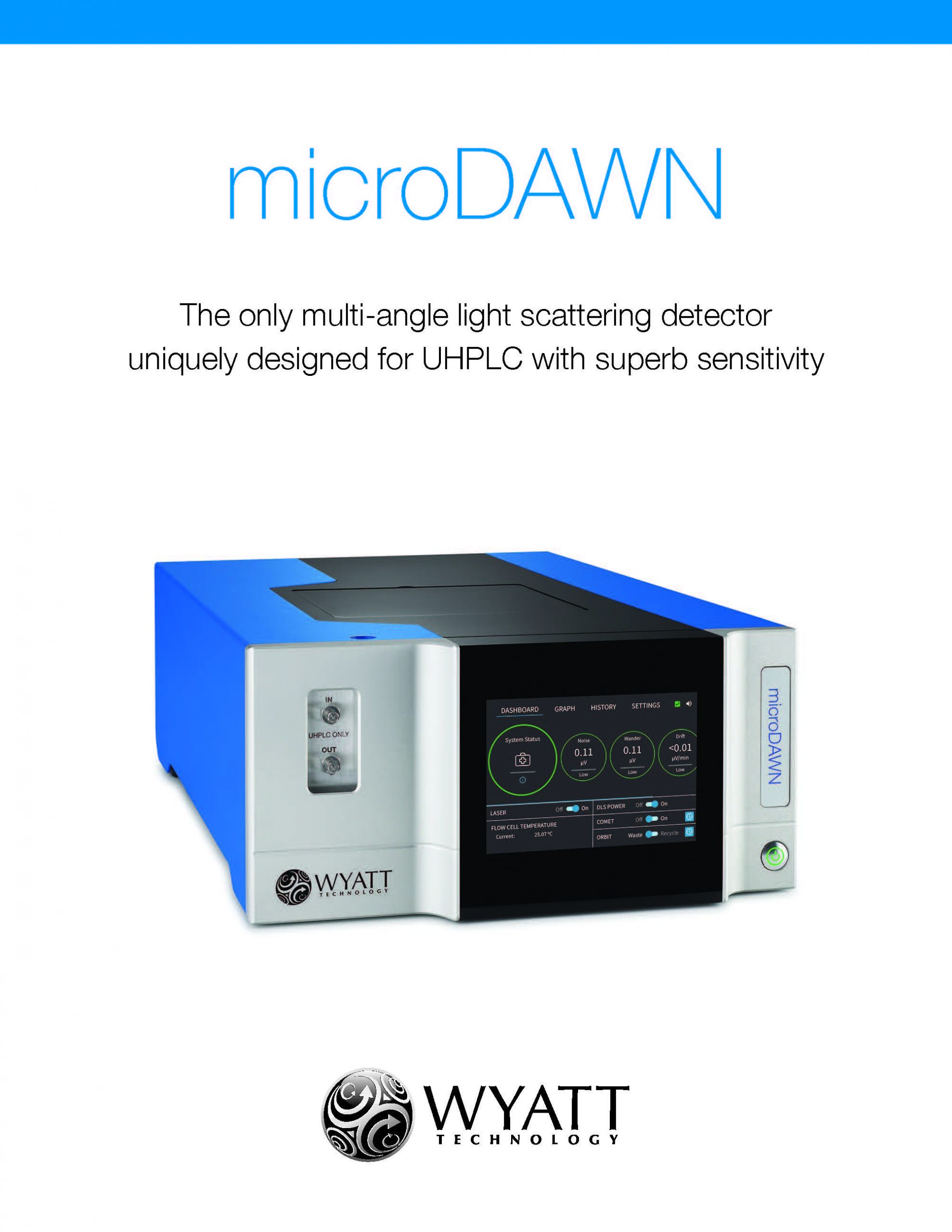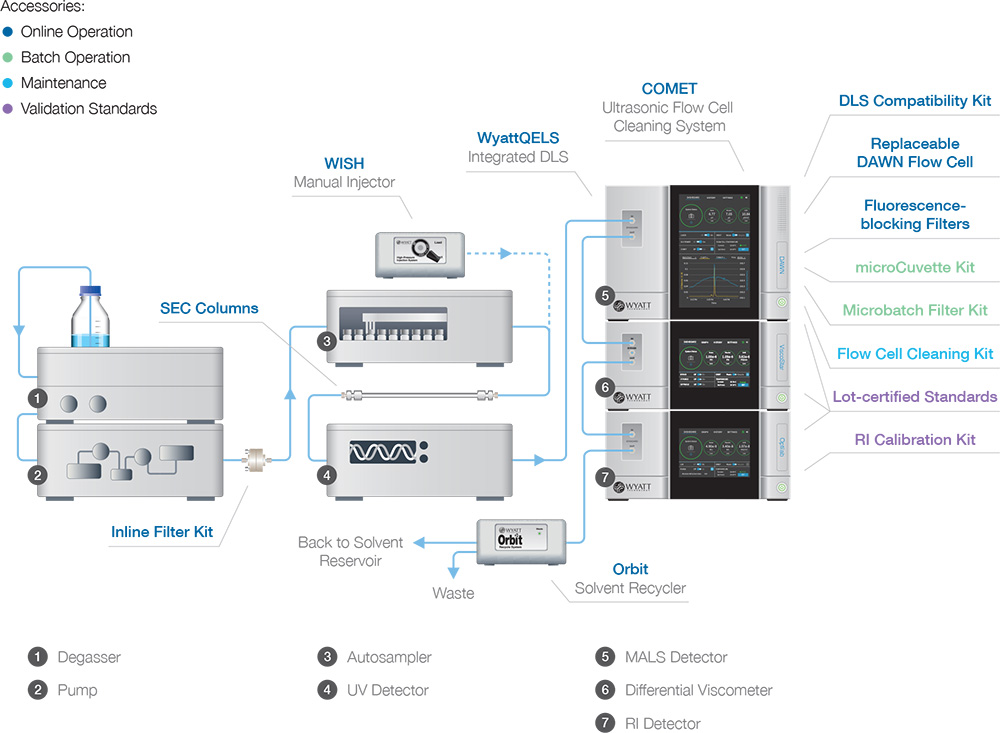microDAWN
Product Overview
Product Description
Brochure
On-Line Operation
Options
Accessories
Software
Specifications
Testimonials
Other MALS Instruments
Publications
Request Info
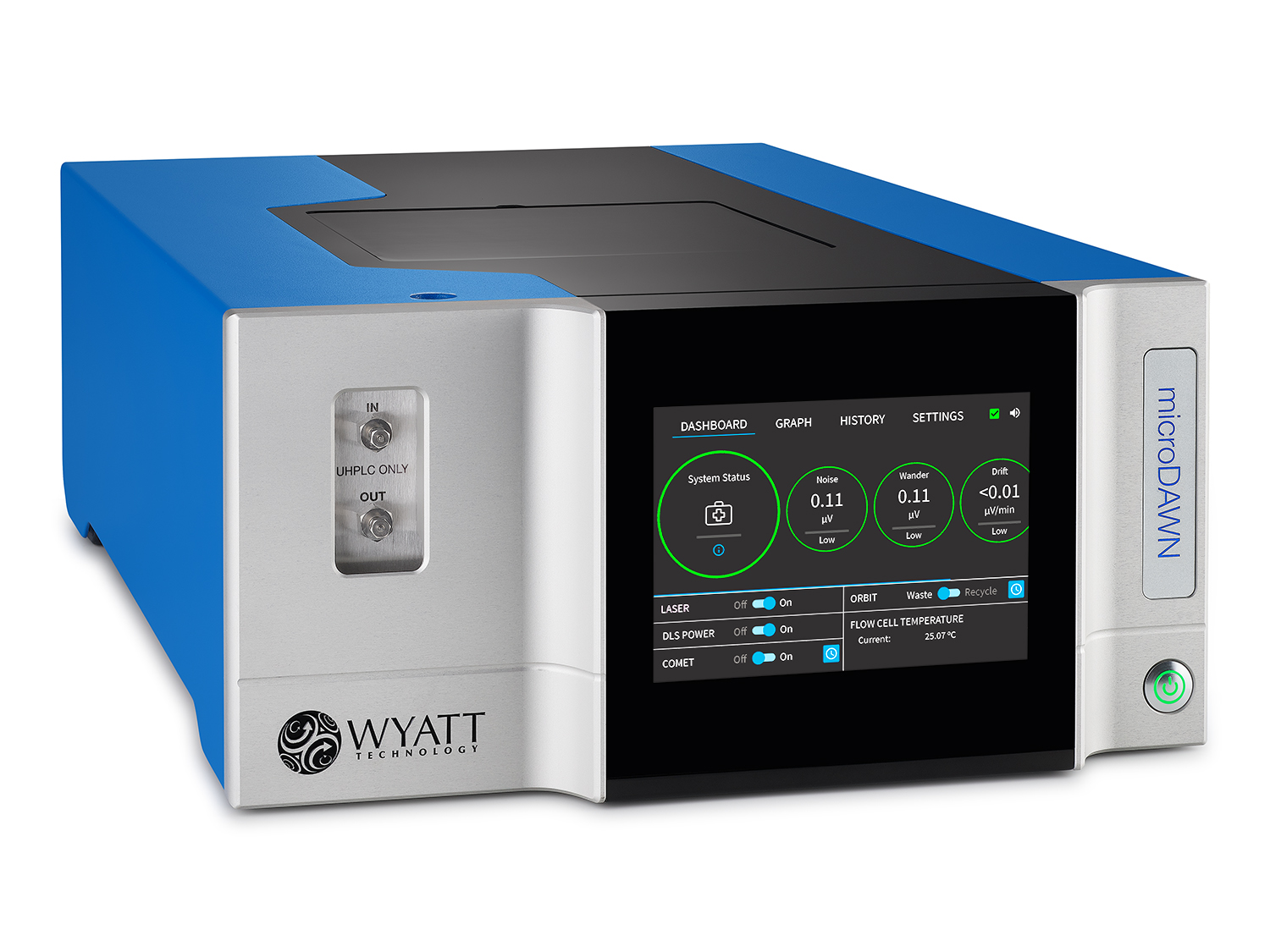
The Only Multi-Angle Light Scattering Detector for UHPLC.
UHPLC-SEC System
The microDAWN™ can be coupled to any UHPLC-SEC system to determine absolute molecular weights and sizes of polymers, peptides, or proteins directly, without resorting to column calibration or reference standards. The microDAWN produces minimal band broadening in order to maintain the narrow peaks typical of UHPLC, while meeting or exceeding the sensitivity of the miniDAWN®.
Polymer Characterization
Read our paper published in Nature Scientific Reports: “Measuring proteins with greater speed and resolution while reducing sample size”.
Use of SEC-MALS
Download our white paper on the microDAWN: “Absolute characterization of polymers with light scattering and UHP-SEC”.
The microDAWN MALS detector performs absolute characterization of macromolecules eluting from UHPLC, determining molar mass and size independently of retention time and molecular reference standards. This instrument offers superb sensitivity over a wide range of molar mass, size and concentrations. In most respects the microDAWN is similar to the well-established miniDAWN™, a workhorse MALS instrument used in hundreds of labs around the world for characterizing proteins and other molecules smaller than 50 nm in radius.
Distinctly from the miniDAWN, the microDAWN is uniquely suitable for use in conjunction with UHPLC Size Exclusion Chromatography (SEC-MALS) thanks to its small interdetector dispersion. In some cases it may be used with ion-exchange or other types of chromatography. Regardless of the specifics, the microDAWN produces minimal band broadening in order to maintain the narrow peaks typical of UHPLC.
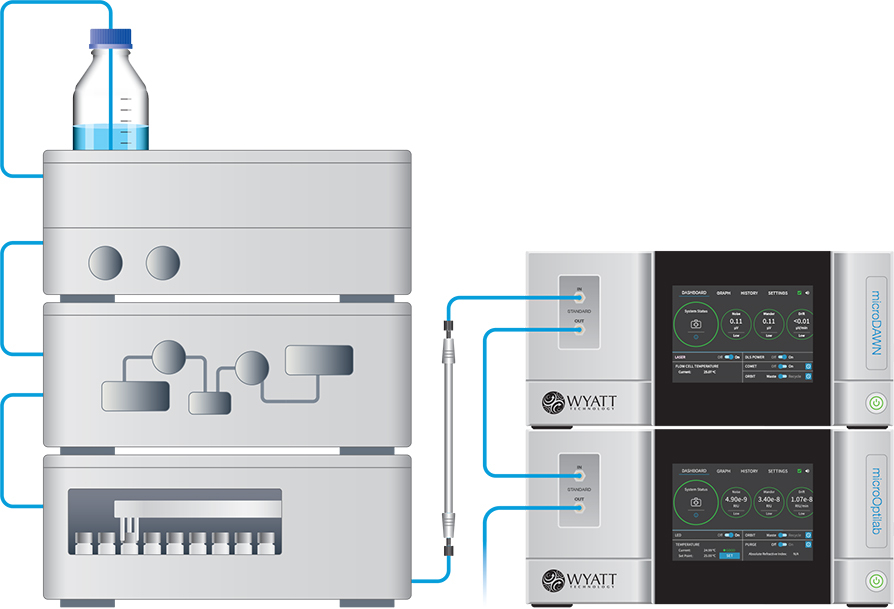
- Mw from 200 Da to 10 MDa
- Sensitivity: 1.0 µg/mL BSA (66.4 kDa) in PBS; 50 ng/mL 100 kDa polystyrene in THF.
- Rg from 10 to 50 nm
- Ultra-stable laser
The microDAWN and its companion microOptilab™Refractive Index Detector interface to most standard UHPLC systems. As these detectors are based on the advanced technology of Wyatt's miniDAWN and Optilab™, respectively, users may be confident in the underlying capabilities cited in thousands of peer-reviewed publications.
Ultrasonic Cleaning Included
Each microDAWN includes a COMET™ ultrasonic transducer that cleans MALS flow cells automatically by agitating the fluid and loosening particles from the glass surfaces.
The only multi-angle light scattering detector uniquely designed for UHPLC with superb sensitivity
Click here to request a copy of our microDAWN brochure.
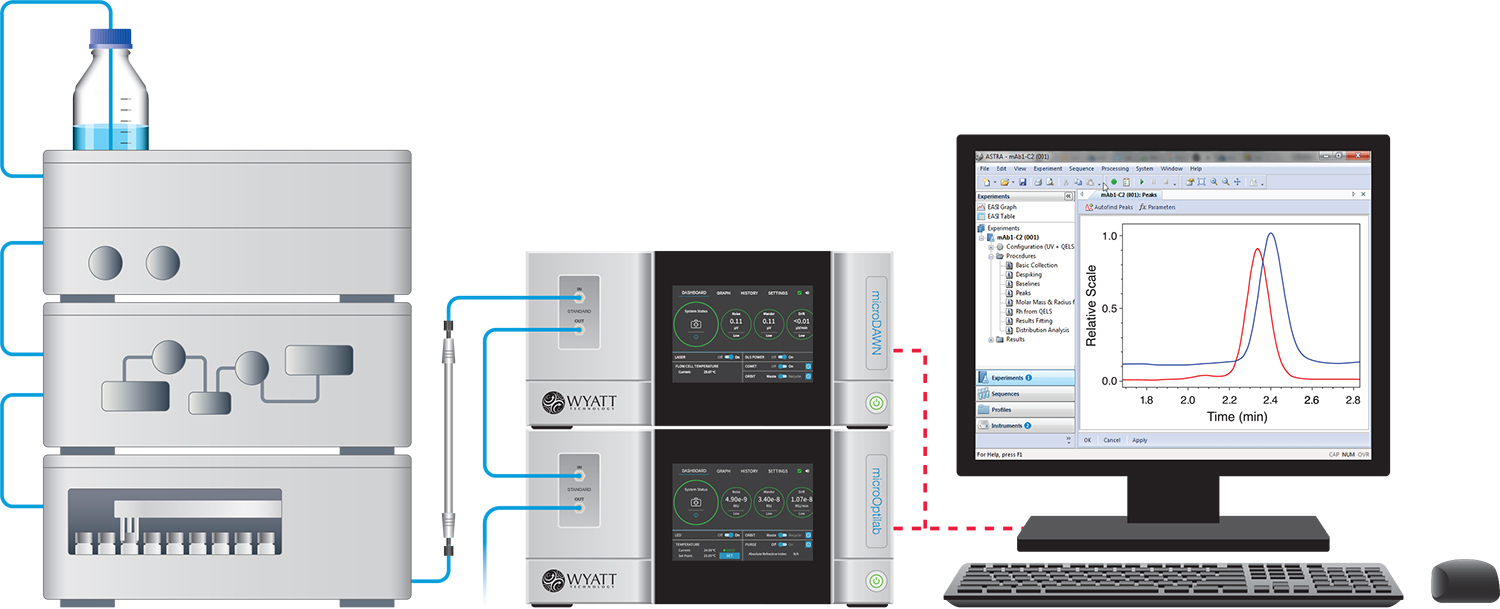
The microDAWN will work downstream of all types of UHPLC systems for analysis of molar mass and size distributions (see SEC-MALS), and derivatives such as conformational analysis. For those systems equipped with a UV, RI, fluorescence or other type of concentration detector, the microDAWN accepts up to 4 analog inputs so a 3rd-party concentration signal may be used in MALS calculations of molar mass. The microDAWN is set up downstream of a UV detector and upstream of a RI detector.
In most cases it is beneficial to connect an microOptilab as well as a UV detector. This permits universal concentration detection regardless of fluorophores or chromaphores. The combination of UV and RI signals is utilized in ASTRA's Conjugation Analysis algorithm to characterize binary complexes such as glycoproteins, PEGylated proteins, membrane proteins enveloped in surfactant, or block co-polymers.
WyattQELS™ DLS Module - To determine size and conformation, the WyattQELS measures hydrodynamic radius of eluting macromolecules in the same flowcell as the MALS detectors. This fully integrated module guarantees dispersionless correlation between molar mass, rms radius and hydrodynamic radius.
Alternatively, connect an external DLS instrument via fiber optic cable - both the DynaPro™ NanoStar™ and DynaPro™ ZetaStar™ can do double duty as batch and online DLS instruments. Since they collect light directly from the MALS flow cell, the mass/size correlation is still dispersionless.
ASTRA™ - Our comprehensive software solution for MALS and DLS analysis in chromatography, field flow fractionation or batch mode.
ASTRA offers a suite of basic and advanced analyses, including customized reports and an optional 21 CFR Part 11 compliant security and database package.
Optional HPLC CONNECT software provides integrated control of your UHPLC stack with full digital synchronization between your UHPLC system and Wyatt detectors – all within ASTRA.
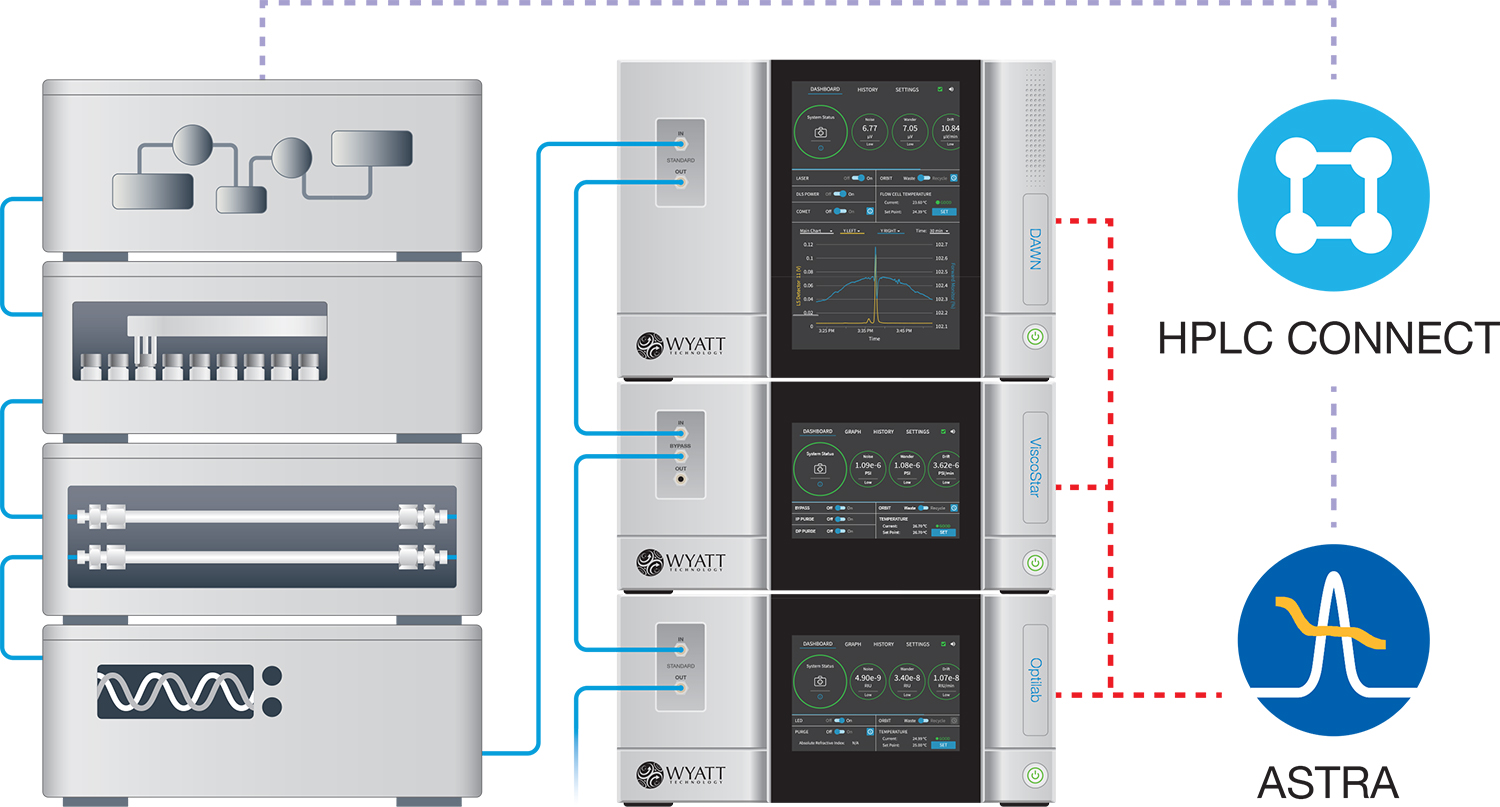
ASTRA's Method Builder simplifies the specification of methods for the most common analyses, in three intuitive steps:
- Choose your scientific application
- Specify the instruments
- Enter sample and run parameters
Maximize your productivity via ASTRA's One-Click MW™ feature, automated multi-sequence processing and HPLC/UHPLC integration. ASTRA will:
- Synchronize data collection with your HPLC or UHPLC
- Autoprocess data to determine MW and radius
- Generate custom reports and graphs
- Prepare for the next run
| Measurements | |
| Molar Mass Range | 200 Da to 10 MDa (proteins) or 1 MDa (linear polymers)1 |
| Molecular or Particle Size Range (Radius, Rg) | 10 nm to 50 nm, up to 150 nm with shape-specific models |
| Molecular Size Range (Rh) | In flow mode, 0.5 nm to 30 nm; batch mode 0.5 nm to 1 μm (requires WyattQELS DLS module or DynaPro® NanoStar® + fiber optic connection)2 |
| Sensitivity | 3.5 ng of 100 kDa polystyrene in THF or 70 ng of BSA in PBS, assuming a 15 cm UHPLC-SEC column and no post-column filter |
| Optics | |
| Detectors | |
| MALS Detectors | High-gain, high dynamic range photodiodes at 3 detection angles |
| Dynamic Range | 3,300,000:1 |
| Auxiliary Detectors | Laser monitor for stabilization feedback; forward transmission monitor to correct signals for absorbing samples and to assess data quality |
| DLS Detector (optional) | WyattQELS dynamic light scattering module installs directly inside the microDAWN chassis. Alternatively, the optical fiber pickup of the DynaPro NanoStar cuvette-based DLS instrument or Mobius DLS-ELS instrument may be installed in the DAWN. |
| Laser Properties | |
| Laser Wavelength | 658 nm ± 4 nm |
| Laser Power Control | Programmable 10% to 100% |
| Sample Temperature Control | Ambient |
| Interdetector Band Broadening | (Increase in FWHM @ 0.3 mL/min) Upstream detector to microDAWN: < 1.5 μL; Upstream detector to downstream detector: < 1.6 μL |
| Wetted Materials | 316 stainless steel, fused silica, PEEK, PTFE, MP35N iron-free alloy |
| Electronics | |
| Analog Inputs | 2 differential analog inputs with 24 bit resolution; Input range -10 V to +10 V |
| Analog Outputs | 1 analog output from user selectable measurements channels -10 V to +10 V |
| Other Inputs/Outputs | Alarm in, Alarm out/retransmit, Auto-inject in, Auto inject contact closure retransmit, Recycle In/Out (operates Orbit™ recycle valve) |
| Computer Interface | Ethernet |
| Front Panel Display | 7" (178 mm), high-resolution, multi-touch display for viewing/setting signals, instrument settings and diagnostics |
| Processed Data Transmission Rate | Up to 73 Hz |
| Dimensions | 58 cm (L) x 36 cm (W) x 18 cm (H) |
1Depending on dn/dc, the sample concentration and chromatography conditions, this is typical.
2The upper size limit is set by the rms radius of the molecule, with a maximum size for reliable Mw of 50 nm.
Host PC requirements may be found in Computer Requirements.
Specifications subject to change without notice.
Other MALS Instruments
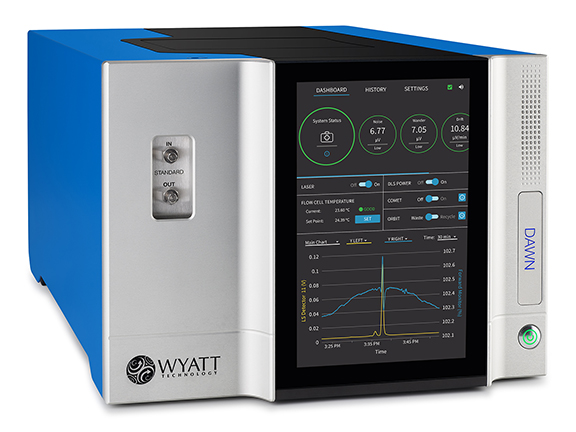
DAWN™ - The most sensitive MALS detector available, anywhere. Incorporates detectors at 18 angles to determine molar masses from 200 Da to 1 GDa and radii from 10 – 500 nm.
- Standard option: ambient temperature
- Heated/cooled option: -15 °C to +150 °C
- High-temperature option: ambient to +210 °C
The DAWN offers special options to handle fluorescent samples: fluorescence-blocking filters and an infrared, 785 nm laser.
miniDAWN™ - Second only to the DAWN in sensitivity. Incorporates detectors at 3 angles to determine molar masses from 200 Da to 10 MDa and radii from 10 – 50 nm. Ambient only.
ultraDAWN™ - Measures multi-angle light scattering and reports the results – weight-average molecular weight Mw and rms radius Rg – in real time.

